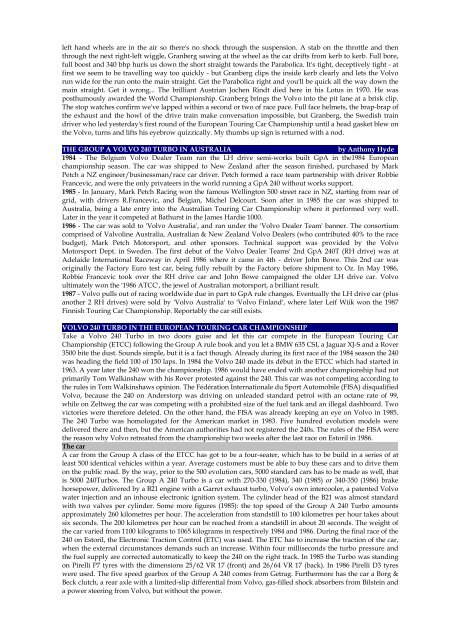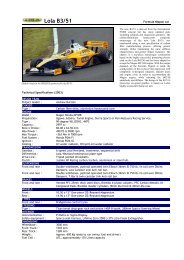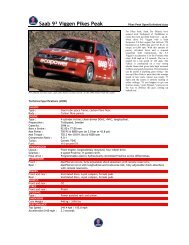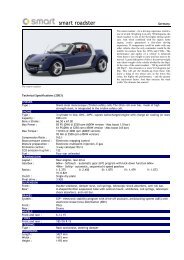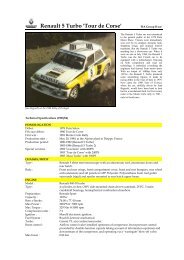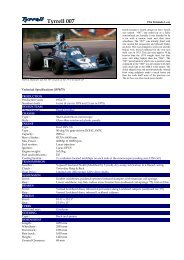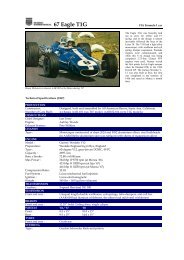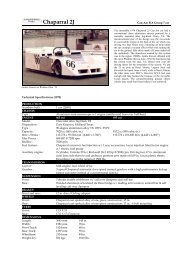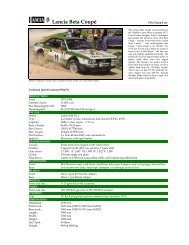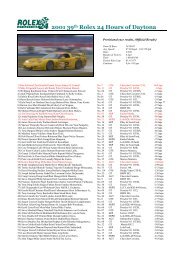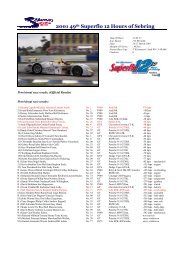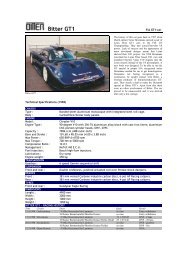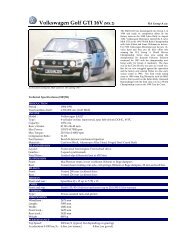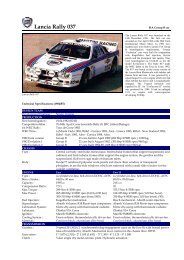85 Volvo 240 Turbo - Motorsports Almanac
85 Volvo 240 Turbo - Motorsports Almanac
85 Volvo 240 Turbo - Motorsports Almanac
You also want an ePaper? Increase the reach of your titles
YUMPU automatically turns print PDFs into web optimized ePapers that Google loves.
left hand wheels are in the air so there's no shock through the suspension. A stab on the throttle and then<br />
through the next right-left wiggle, Granberg sawing at the wheel as the car drifts from kerb to kerb. Full bore,<br />
full boost and 340 bhp hurls us down the short straight towards the Parabolica. It's tight, deceptively tight - at<br />
first we seem to be travelling way too quickly - but Granberg clips the inside kerb clearly and lets the <strong>Volvo</strong><br />
run wide for the run onto the main straight. Get the Parabolica right and you'll be quick all the way down the<br />
main straight. Get it wrong... The brilliant Austrian Jochen Rindt died here in his Lotus in 1970. He was<br />
posthumously awarded the World Championship. Granberg brings the <strong>Volvo</strong> into the pit lane at a brisk clip.<br />
The stop watches confirm we've lapped within a second or two of race pace. Full face helmets, the brap-brap of<br />
the exhaust and the howl of the drive train make conversation impossible, but Granberg, the Swedish train<br />
driver who led yesterday's first round of the European Touring Car Championship until a head gasket blew on<br />
the <strong>Volvo</strong>, turns and lifts his eyebrow quizzically. My thumbs up sign is returned with a nod.<br />
THE GROUP A VOLVO <strong>240</strong> TURBO IN AUSTRALIA by Anthony Hyde<br />
1984 - The Belgium <strong>Volvo</strong> Dealer Team ran the LH drive semi-works built GpA in the1984 European<br />
championship season. The car was shipped to New Zealand after the season finished, purchased by Mark<br />
Petch a NZ engineer/businessman/race car driver. Petch formed a race team partnership with driver Robbie<br />
Francevic, and were the only privateers in the world running a GpA <strong>240</strong> without works support.<br />
19<strong>85</strong> - In January, Mark Petch Racing won the famous Wellington 500 street race in NZ, starting from rear of<br />
grid, with drivers R.Francevic, and Belgian, Michel Delcourt. Soon after in 19<strong>85</strong> the car was shipped to<br />
Australia, being a late entry into the Australian Touring Car Championship where it performed very well.<br />
Later in the year it competed at Bathurst in the James Hardie 1000.<br />
1986 - The car was sold to '<strong>Volvo</strong> Australia', and ran under the '<strong>Volvo</strong> Dealer Team' banner. The consortium<br />
comprised of Valvoline Australia, Australian & New Zealand <strong>Volvo</strong> Dealers (who contributed 40% to the race<br />
budget), Mark Petch Motorsport, and other sponsors. Technical support was provided by the <strong>Volvo</strong><br />
Motorsport Dept. in Sweden. The first debut of the <strong>Volvo</strong> Dealer Teams' 2nd GpA <strong>240</strong>T (RH drive) was at<br />
Adelaide International Raceway in April 1986 where it came in 4th - driver John Bowe. This 2nd car was<br />
originally the Factory Euro test car, being fully rebuilt by the Factory before shipment to Oz. In May 1986,<br />
Robbie Francevic took over the RH drive car and John Bowe campaigned the older LH drive car. <strong>Volvo</strong><br />
ultimately won the '1986 ATCC', the jewel of Australian motorsport, a brilliant result.<br />
1987 - <strong>Volvo</strong> pulls out of racing worldwide due in part to GpA rule changes. Eventually the LH drive car (plus<br />
another 2 RH drives) were sold by '<strong>Volvo</strong> Australia' to '<strong>Volvo</strong> Finland', where later Leif Wiik won the 1987<br />
Finnish Touring Car Championship. Reportably the car still exists.<br />
VOLVO <strong>240</strong> TURBO IN THE EUROPEAN TOURING CAR CHAMPIONSHIP<br />
Take a <strong>Volvo</strong> <strong>240</strong> <strong>Turbo</strong> in two doors guise and let this car compete in the European Touring Car<br />
Championship (ETCC) following the Group A rule book and you let a BMW 635 CSI, a Jaguar XJ-S and a Rover<br />
3500 bite the dust. Sounds simple, but it is a fact though. Already during its first race of the 1984 season the <strong>240</strong><br />
was heading the field 100 of 150 laps. In 1984 the <strong>Volvo</strong> <strong>240</strong> made its début in the ETCC which had started in<br />
1963. A year later the <strong>240</strong> won the championship. 1986 would have ended with another championship had not<br />
primarily Tom Walkinshaw with his Rover protested against the <strong>240</strong>. This car was not competing according to<br />
the rules in Tom Walkinshaws opinion. The Fédération Internationale du Sport Automobile (FISA) disqualified<br />
<strong>Volvo</strong>, because the <strong>240</strong> on Anderstorp was driving on unleaded standard petrol with an octane rate of 99,<br />
while on Zeltweg the car was competing with a prohibited size of the fuel tank and an illegal dashboard. Two<br />
victories were therefore deleted. On the other hand, the FISA was already keeping an eye on <strong>Volvo</strong> in 19<strong>85</strong>.<br />
The <strong>240</strong> <strong>Turbo</strong> was homologated for the American market in 1983. Five hundred evolution models were<br />
delivered there and then, but the American authorities had not registered the <strong>240</strong>s. The rules of the FISA were<br />
the reason why <strong>Volvo</strong> retreated from the championship two weeks after the last race on Estoril in 1986.<br />
The car<br />
A car from the Group A class of the ETCC has got to be a four-seater, which has to be build in a series of at<br />
least 500 identical vehicles within a year. Average customers must be able to buy these cars and to drive them<br />
on the public road. By the way, prior to the 500 evolution cars, 5000 standard cars has to be made as well, that<br />
is 5000 <strong>240</strong><strong>Turbo</strong>s. The Group A <strong>240</strong> <strong>Turbo</strong> is a car with 270-330 (1984), 340 (19<strong>85</strong>) or 340-350 (1986) brake<br />
horsepower, delivered by a B21 engine with a Garret exhaust turbo, <strong>Volvo</strong>’s own intercooler, a patented <strong>Volvo</strong><br />
water injection and an inhouse electronic ignition system. The cylinder head of the B21 was almost standard<br />
with two valves per cylinder. Some more figures (19<strong>85</strong>): the top speed of the Group A <strong>240</strong> <strong>Turbo</strong> amounts<br />
approximately 260 kilometres per hour. The acceleration from standstill to 100 kilometres per hour takes about<br />
six seconds. The 200 kilometres per hour can be reached from a standstill in about 20 seconds. The weight of<br />
the car varied from 1100 kilograms to 1065 kilograms in respectively 1984 and 1986. During the final race of the<br />
<strong>240</strong> on Estoril, the Electronic Traction Control (ETC) was used. The ETC has to increase the traction of the car,<br />
when the external circumstances demands such an increase. Within four milliseconds the turbo pressure and<br />
the fuel supply are corrected automatically to keep the <strong>240</strong> on the right track. In 19<strong>85</strong> the <strong>Turbo</strong> was standing<br />
on Pirelli P7 tyres with the dimensions 25/62 VR 17 (front) and 26/64 VR 17 (back). In 1986 Pirelli D3 tyres<br />
were used. The five speed gearbox of the Group A <strong>240</strong> comes from Getrag. Furthermore has the car a Borg &<br />
Beck clutch, a rear axle with a limited-slip differential from <strong>Volvo</strong>, gas-filled shock absorbers from Bilstein and<br />
a power steering from <strong>Volvo</strong>, but without the power.


